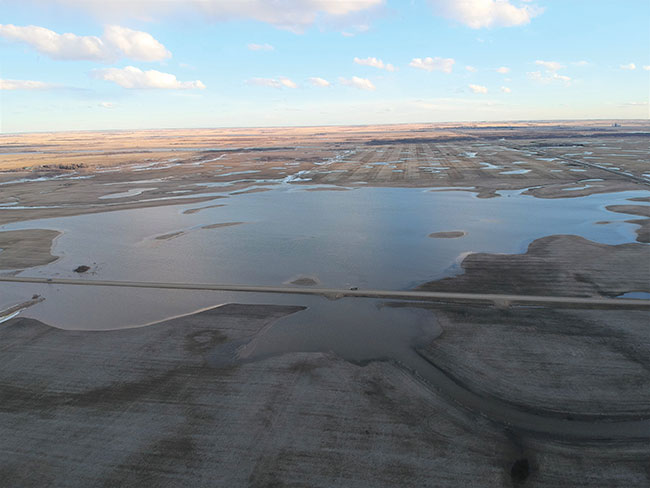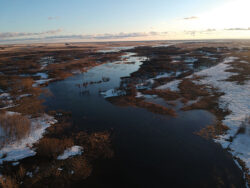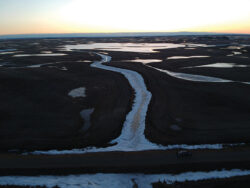
Features
Business
High-functioning, farmer-run
Lessons learned from the Tetlock Conservation and Development Area Authority.
November 21, 2023 By JULIENNE ISAACS
 Owen's holding pond picture on April 10, 2022. Two days later, the C&D was opened with a digger.
All images courtesy of Candace Mitschke
Owen's holding pond picture on April 10, 2022. Two days later, the C&D was opened with a digger.
All images courtesy of Candace Mitschke The Tetlock Conservation and Development Area Authority (Tetlock C&D) has a major claim to fame: it’s a drainage management network in Canada cooperatively run by landowners – and it has operated for nearly seven decades.
The Tetlock C&D operates on 64 quarters of land near Grenfell, SK, where Three Mile Creek discharges into Ekapo Creek and finally the Qu’Appelle River. It’s an area with very slight elevation that, in the 1950s, was very wet, says Ryan Maurer, a partner at Land and Sky Grains and a landowner in the network.
That’s when the Saskatchewan Department of Highways identified the need for drainage in the area. The original drainage ditches were constructed with dynamite in the 1950s. But by the 1970s, the department had asked local landowners to form a board to maintain the ditches, or they’d close the project. The farmers agreed: the value of drainage to their land was already clear. Over the years, they’ve maintained and improved the existing network and added more land and ditches–investments totalling roughly 3.5 to four million dollars, says Maurer.
The network now includes 13 landowners and 10 yard sites, six of them at very high risk of spring flooding. But the impacts of the C&D are felt beyond these 64 quarters, says Maurer.
“To the best of our knowledge, no road within our boundary has ever been washed out. It is benefiting all those around,” he says.
The Tetlock C&D makes use of control gates, culvert sizing to reduce and slow down spring flow, some tile piping and hold-back ponds, which have been key to the project’s success, he adds. Snow also acts as a control structure in the ditches until it melts out in spring.
The purpose of the hold-back ponds, which range in size from 20 to 150 acres and are connected to the network via control gates, is to hold back the flow of water until spring runoff has mostly been expended, says Maurer. Not all the holding ponds are fully drained; a few are purposely left below grade to function as a seasonal wetland and habitat area.
“[The system] provides controlled, timely release of this water. Not only does it hold back the water that has been drained, it holds back all the water–the natural water that would be entering the system is being held back also,” he explains.
“These retention areas or hold-back ponds hold water temporarily in the spring or during an extreme weather event in season, and that’s at the expense of farmers in the area willing to provide flood control,” adds Candace Mitschke, executive director of the Saskatchewan Farm Stewardship Association (SaskFSA).
SaskFSA works closely with the Tetlock C&D, says Mitschke, thanks to its unique mandate. “SaskFSA was formed for farmers to have a voice when it came to managing land and water,” says Mitschke. “It is producer-led. No other province has an association like this. Often policy is made from the desk, [but] our job is to ensure that it is practical from the progressive farm business perspective.”
Flood control
In the spring, a massive amount of flow goes through the area’s arteries to Three Mile Creek and eventually the Qu’Appelle river. “In spring when all the natural runs are flowing, that’s when the problems start downstream because there’s no control on those natural arteries,” says Maurer.

Three Mile Creek’s spring flooding had begun to recede when pictured on April 6, 2022.
It’s hard to see how it all works from ground-level, but the system’s effectiveness can be seen from the air, and over the last few years the network has worked hard to capture drone footage documenting the flow of water through the area and the efficacy of the hold-back ponds. The community has occasionally questioned whether flooding in the area is at least partly the fault of the C&D.
“But it’s all natural,” says Maurer. In spring, the creek overflows its banks with natural snowmelt long before snow has melted in the C&D channels. By summer, the creek’s flow is well within its banks.
Drone footage from one holding pond, which sits on C&D member Owen Pekrul’s land, illustrates the point: in 2022, Three Mile Creek started to flow on March 24; the flow was receding by April 6, and by mid-April, Three Mile Creek showed low flow. The C&D discharge only opened on April 16, and Owen’s holding pond still hadn’t emptied by April 25, showing that drainage did not contribute to peak flow.
In fact, on April 12 that year, the main control ditch at Owen’s holding pond was still clogged with ice and had to be opened with a trackhoe–a very rare occurrence, says Maurer.
“I’m always amazed by the amount of time that goes into monitoring these drainage networks– [the farmers] don’t just establish them and walk away from them. The behind-the-scenes maintenance that goes on is not always appreciated the way it should be,” says Mitschke.
The network’s farmers pay a levy to Tetlock C&D of roughly $2.50 per acre to help with maintenance costs.
It’s worth it for the area’s farmers, says Maurer, particularly when land is heavily potholed. And devoting land to holding ponds is also worth the cost of seeding toward the end of the planting window. “I have seen Owen Pekrul seed that land a week to 10 days after everybody else has planted their crops–but if it wasn’t for that ditch in there, he wouldn’t be seeding that at all, because it’s a low, flat area vulnerable to holding water some years, [as well as being vulnerable to] weeds, mud, salinity and crop loss,” says Maurer.
“In some of those high rainfall years they would have lost a lot of acres with rainfall anyway. It takes the right people to understand they’re getting a benefit.”
After drainage, Maurer adds, the approximate increase in land value is $50,000 per quarter, and an additional $195 per quarter paid to the local rural municipality.
Lessons
After nearly 70 years of maintaining and growing the Tetlock C&D, the area’s farmers have learned too many lessons to recount.

The Tetlock C&D was still frozen over on April 6, 2022.
But one significant lesson, says Maurer, is the importance of working with your neighbors.
One big example happened in 2015. In the 1990’s, the land where the ditch ended was sold to a nearby First Nations band, Mitschke explains. In 2015, when a government rule was instituted on point of adequate outlet (POA), the landowners discovered that the last 100 metres did not have an easement to the C&D and no longer qualified as POA. The solution: the provincial Water Security Agency and the C&D worked with the band to secure the sale of those 100 metres back to the Crown.
“They helped us work through that dilemma,” says Maurer. After several years of negotiations, the final 100 metres of the drainage ditch were kept under the purview of the C&D through a legal subdivision in the name of the Crown.
“This is a prime example of how important it is to have a farmer voice when building water management policy,” Mitschke adds.
Speaking up about the value of water management systems can make a big difference within the community.
“I sit on the local RM council to be part of the solution and have come to realise there is a lot of misinformation within the RM regarding water management,” says Maurer. “The word ‘drainage’ can be negative, so [instead] we say, ‘Through drainage we are managing our water quantity and flow.’ If you can take the time to explain the difference between uncontrolled drainage and responsible drainage (or water management) with someone who is willing to listen and learn, they walk away with a whole new view,” he says.
This past April, SaskFSA held a Water Management Day at the Maurers’ farm. At least 150 people were in attendance–some of whom had driven for more than two hours to attend. It’s not always comfortable for farmers to speak up, says Maurer–but working together to spread their message can be just as effective as working together to mitigate flood risk.
“Farmers are notorious for putting their heads down to work–we’re not lobbyists. But by working together with a common goal, it’s working well, it’s taken off,” he says. DC
Print this page